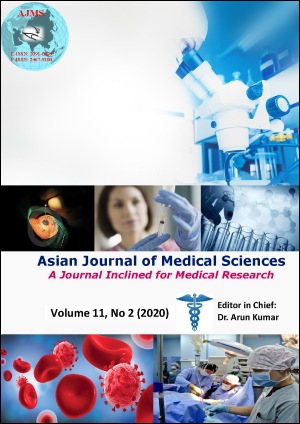Assessment of serum Ferritin level and its correlation with HbA1c in Diabetic Nephropathy
Keywords:
Serum Ferritin, glycated hemogobin, diabetic nephropathy, Iron overloadAbstract
Background: Serum ferritin levels reflecting the body iron stores, is known to be elevated in type 2 Diabetes Mellitus. However its association with diabetic complications including Diabetic nephropathy (DN), and overall glycemic control needs to be validated.
Aims and Objectives: The aim of this study was to find the Serum Ferritin level abnormalities in DM patients with nephropathy in comparison with DM patients without nephropathy and to find correlation of Serum Ferritin (SF) levels with levels of Glycated Hemoglobin (HbA1c) in patients with diabetic nephropathy.
Materials and Methods: This is a retrospective study, which included eighty five registered patients with Type 2 DM (44 Type II DM without nephropathy cases and 41 cases of Type II DM with nephropathy). SF and HbA1c was estimated in all cases across both the groups and were compared with age and sex matched controls and analysed.
Results: Serum Ferritin levels were higher in diabetics with nephropathy compared to diabetics without nephropathy (p<0.0001). SF levels were higher in diabetic groups compared to control group (p <0.001).The correlation between HbA1c and SF was assessed among all cases of DM with nephropathy group using pearson correlation test and it showed a significantly positive correlation (r=0.431) with a SF (mean = 938±148) and HbA1c (mean = 9.2±2.02).
Conclusion: Serum ferritin levels positively correlate with HbA1c levels in Type II DM cases with nephropathy, which suggests that serum Ferritin levels can be used as a surrogate marker of glycemic control in Type II DM with nephropathy.
Downloads
Downloads
Published
How to Cite
Issue
Section
License
Authors who publish with this journal agree to the following terms:
- The journal holds copyright and publishes the work under a Creative Commons CC-BY-NC license that permits use, distribution and reprduction in any medium, provided the original work is properly cited and is not used for commercial purposes. The journal should be recognised as the original publisher of this work.
- Authors are able to enter into separate, additional contractual arrangements for the non-exclusive distribution of the journal's published version of the work (e.g., post it to an institutional repository or publish it in a book), with an acknowledgement of its initial publication in this journal.
- Authors are permitted and encouraged to post their work online (e.g., in institutional repositories or on their website) prior to and during the submission process, as it can lead to productive exchanges, as well as earlier and greater citation of published work (See The Effect of Open Access).




